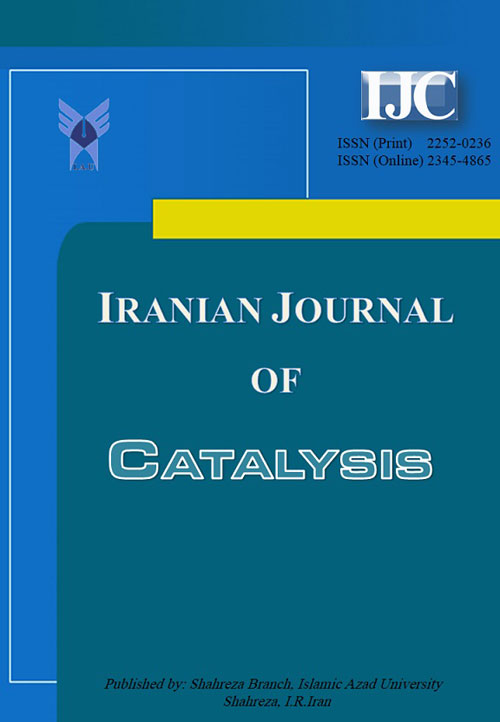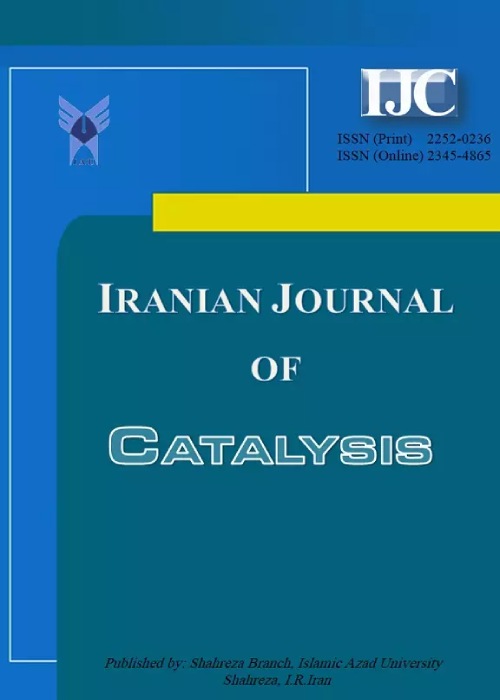فهرست مطالب

Iranian Journal of Catalysis
Volume:11 Issue: 4, Autumn 2021
- تاریخ انتشار: 1400/10/13
- تعداد عناوین: 9
-
-
Pages 331-345
This review focuses on the usage of nano–sized catalysts in eco–remedial for polluted air and water. The metal nanomaterials, metal oxide-based nano-photocatalysts, and non-metallic nanomaterials have the proficiency for inactivating viruses and purifying air. These nano catalysts have more active sites at their surface in comparison with normal materials and hence more effective catalysts. In eco-remedial, the nano–sized catalyst provides increased possibility for effective deletion of contaminants and organic impurities from air and water. Nano–sized catalyst in several forms/structures, like nano–sized particles, fibres, wires, tubes etc., serves as adsorbents and catalysts which are used for the elimination of toxic gases in air, polluted elements, biological contaminants and organic materials such as viruses, bacteria, parasites and antibiotics. Nano catalysts enhance the chemical reaction speed and can make the reaction more effective and more efficient. Nano–sized catalyst provides an improved act in eco remedial measures than other regular methods due to their high surface area and their accompanying great reactivity. Numerous nanosized materials were synthesized and designed for environmental protection purpose. Novel developments in the making of new nano–sized catalyst and procedures are stressed for action of - intake water and industrialized wastewater polluted by poisonous radionuclides, metal ions, organic and inorganic solutes, bacteria and viruses and action of air. There are two important ways through which nanotechnology is being used to reduce air pollution: a) nano-sized catalysts, which are constantly being improved and widely used in various areas and b) nano-structured membranes, with highly active adsorbing and absorbing sites.
Keywords: Nano – Sized Materials, catalyst, Eco Remedial Activities, Air Purifier, Water Purifier -
Pages 347-354
The preparation and application of novel nanocatalysts for oxidation reaction via a simple, effective, green method remains a challenge; thus, in this study, a facile and eco-friendly approach is suggested to fabricate pomegranate peel extract (PPE) functionalized on silicate-coated Fe3O4 nanoparticles (Fe3O4@SiO2-PPE). The physicochemical characteristics of the magnetic Fe3O4@SiO2-PPE nanocomposite were evaluated using Fourier-transform infrared spectroscopy (FT-IR), X-ray diffraction (XRD), scanning electron microscopy (SEM), and transmission electron microscopy (TEM) techniques. SEM images showed well-distributed nanoparticles in shape and size with a mean diameter of 42 nm. FT-IR and TEM images proved appropriate functionalization with pomegranate peel extract. The Fe3O4@SiO2-PPE nanocatalyst was found to be useful in the selective oxidation of benzyl alcohols to the relevant aldehydes/ketones without significant over oxidation and with good-to-excellent (about 95%) yields under solvent-free conditions at room temperature. The results revealed that the prepared catalyst was easily recovered and reused for five consecutive oxidation cycles without losing selectivity towards desired products in the benzyl alcohol oxidation.
Keywords: Pomegranate peel extract, Iron oxide nanoparticle, catalyst, Oxidation -
Pages 355-362
This work describes the simplest method of synthesis of a carbonized cobalt catalyst based on an available natural mineral, clay activated with nitric acid, which showed high selectivity and activity in hydrogenation of acetylene to ethylene. Metal catalysts with cobalt contents of 5 %-7 % in a bentonite clay carrier from the Tonkeris deposit were synthesised. The physicochemical properties were investigated by means of X-ray powder diffraction (XRD), scanning electron microscope (SEM), IR-Fourier spectrometer. Products were analysed using a Chrom-3700 gas chromatograph and gas chromatography–mass spectrometry (Agilent 7890A/5975C). The catalytic activities of the synthesised cobalt catalysts were investigated using an installation developed for the hydrogenation of acetylene to ethylene in a gaseous medium. Carbon nanofibers with diameters ranging from 57 to 400 nm were visible on cobalt catalyst samples. Selectivity of the modified cobalt-containing catalysts for hydrogenation ranged from 89.62 % to 97 %. Ethylene conversions of 93.58 % were achieved on 7 % Co/SiAl carbonized catalyst, at an optimum temperature of 140 °C. Side reactions are activated when the temperature rises above 180 °C, so the yield of ethylene is reduced.
Keywords: acetylene, Hydrogenation, Catalysts, Carbonization, Cobalt, acid treatment -
Pages 363-375Titanium dioxide nanotubes TNTs were synthesized by anodization in a fluoride-based electrolyte, TNTs are commonly working as photocatalytic under ultraviolet UV irradiation via its wide bandgap, and it was expanded under visible light irradiation by doping with other metals or metals oxides, herein TNTs were doped by copper oxides Cu2O and CuO to produce copper oxides /titanium oxide nanotubes CuOx /TNT. The prepared catalysts (TNTs and CuOx/TNT) were characterized by XRD, FTIR, SEM and, EDX, while catalysts activity was investigated for oxidization of Dibenzothiophene DBT under ultraviolet UV and visible light VL irradiations, the feedstock is model fuel (heptane contains DBT as a sulfur component) was oxidized by hydrogen peroxide H2O2. Results showed that TNT has a moderate catalysis effect under UV irradiation and a low catalysis effect under VL irradiation. CuOx/TNT catalyst exhibited good sensitivity for VL radiation. The study investigated the effect of initial DBT concentration, oxidant dosage, reaction temperature, contact time, and type of irradiation on oxidation desulfurization ODS reaction by using TNT and CuOx/TNT catalysts, the results showed that DBT removal efficiency was increasing with temperature (56.2, 80.4 and 91.2 at 40,50, and 60 °C respectively at 100 minutes) and oxidant amount ( 66.4, 80.4, and 86.1 by adding 5,10,15 ml of oxidant respectively at 100 minutes) while it decreases with the increasing initial BDT concentration (94.8, 80.4, and 86.1 when using 100,150, and 200 ppm as initial DBT concentration at 100 minutes). The kinetics calculations exhibited that ODS reaction under VL irradiation follows pseudo-first-order reaction at CuOx/TNT catalyst with reaction rate constants of 0.00076, 0.0108, and 0.0141 min-1 at 40,50, and 60°C respectively, the activation energy for the reaction is 26.8 kJ/mol, negative ΔS (-0.218 kJ/mol.K) and positive ΔH and ΔG for DBT oxidation under UV irradiation.Keywords: TiO2 Nanotubes, Photocatalyst, Catalysis, reaction kinetics, Desulfurization, Dibenzpthiophene
-
Pages 377-387
The results of studies on obtaining and characterization of silver nanoparticles aqueous solution under the action of the contact non-equilibrium low-temperature plasma and stabilizing agent (sodium citrate) are presented in the paper. The influence of the basic parameters on the synthesis of silver nanoparticles was studied. Different physicochemical characteristics were investigated: initial precursor concentration, reagent ratio, duration of plasma discharge treatment. [Ag+]:[Cit] ratio as 1:1 at silver ion concentrations of Ag+ 0.1-3.0 mmol/L and treatment of the reaction system for 4-5 minutes was found to be appropriate. Under these conditions, the surface plasmon resonance (SPR) was observed at 405-420 nm on UV-Vis spectra. Particles with the average diameter of 35.0 ± 2.0 nm, spherical shape and polydispersity index of 0.032 ± 0.01 are typical amongst synthesized nanoparticles at [1]:[1] molar ratio. It was found that the reaction of nanoparticle dispersion formation was a pseudo-first order reaction with the reaction rate constant of 0.61 min-1. It has been established that sodium citrate is the capping agent and acts only as the stabilizer of Ag NPs. To prepare the nanocomposite material (TiO2/Ag NPs), silver nanoparticles have been deposited on photocatalyst (TiO2 rutile phase) by plasma discharge. EDS and SEM analysis showed that composite material has core–shell structure including Ag nanoparticles (NPs) shell with size of 15-25 nm. The results indicated that TiO2/Ag exhibited good photoactivity under ultraviolet radiation. It was found that 98.7% of tetracycline was decomposed at photocatalyst TiO2/Ag NPs under the light irradiation. The experimental data of photochemical decomposition of tetracycline under the light irradiation at 430 nm showed that reaction is described by the pseudo first order kinetic model with rate constant (k value) of (3.6)×10−3 min−1.
Keywords: silver nanoparticles, citrate, Plasma-liquid phase, Titanium dioxide, Photocatalys, Tetracycline, Degradation -
Pages 389-395Porous ZnO-hydroxyapatite nanocomposite was prepared by dissolution of a rock phosphate ore in an acidic medium followed by alkaline precipitation. Its photocatalytic activity was assessed for the degradation of paracetamol as one of the most commonly prescribed pharmaceutical drugs and methylene blue as dye model. Thanks to its good porosity, the 40ZnHAp nanocomposite adsorbed the selected pollutants better than the individual ZnO and HAp phases. 40ZnHAp calcined at 500° completely degrades the studied pollutants faster than ZnO, although a longer illumination time is required for the degradation of paracetamol. The low-cost 40ZnHAp nanomaterial can be considered as a potential photocatalyst for wastewater treatment due to its high porosity, which facilitates the entrapment of initial pollutants and/or by-products. It leads to a complete mineralization, consequently yielding healthy discharged water.Keywords: ZnO-Hydroxyapatite, nanocomposite, Photocatalysis, Paracetamol, Methylene Blue
-
Removal of Mercury (II) in Aqueous Solution by Using ZnO and ZnO/CdS Nanoparticles as PhotocatalystsPages 397-403Zinc oxide (ZnO) and ZnO/CdS nanoparticles have been synthesized. The samples were characterized by Fourier transform infrared spectroscopy (FT–IR), X-ray diffraction (XRD), and scanning electron microscopy (SEM). Photocatalytic reduction of toxic Hg (II) in aqueous solutions by suspension ZnONPs and ZnO/CdSNPs has been studies under an oxygen atmosphere. Flame atomic absorption (AFM) has been used to determine the concentration of Hg (II) in aqueous solutions. Photocatalytic reduction of Hg (II) was carried out with various ZnO nanoparticles (ZnONPs) concentrations. The optimum concentration of ZnO NPs was obtained at 0.24 mg/L. The highest photo reduction rate was obtained at 0.24 mg/ZnO/CdSNPs concentration. According to the experimental results, the reaction mechanism of ZnONPs and ZnO/CdSNPs illumination to produce oxidizing species and the effect of these species on the Hg (II) in aqueous solution has been suggested.Keywords: nanocomposites, semicoductors, environmental treatments, ZnO nanoparticle
-
Pages 405-416The goal of this research is to create nanostructured metal free phosphorous doped Boron nitride (P-BN) and phosphorous-carbon co-doped Boron nitride (CP-BN) that serve as photocatalysts when exposed to UV light. P-NPs were well diffused in aqueous solution. The nanostructured materials were characterized using XRD, SEM-EDX, and UV-Vis spectrophotometry. Based on the characterization results, phosphorous atoms were doped in the crystal structure of BN. The experimental data and theoretical calculations were used to measure the band gap energy, which was determined to be around 4.2 eV in the experimental case; for this purpose, both Tauc and Kubelka-Munk equations were utilized. Thus, photocatalysis degradation is limited to UV region. To examine the degradation effectiveness of photo-catalysts, toluidine blue (TB) was utilized; it was found that the basic medium was the best for degradation; 16% and 8% of TB were eliminated with CP-BN and P-BN, respectively after one hour degradation. Scavengers such as IPA, Na2C2O4, KBrO3, and ascorbic acid were added to trapping experiments to demonstrate the correct potential energy gap in valance and conduction bands and possible photocatalytic mechanism. Data from trapping experiments show that both the hydroxyl radical and super oxide are responsible for degradation, but electron and hole at valance and conduction bands were of low efficiency because of quick recombination. As regards computational study, the crystal and electronic structures of the P-BN and CP-BN have been studied. The lattice parameters were calculated with the Perdew-Burke-Ernzerhof (PBE), and the bandgaps (Eg) were calculated with the (PBE) as (non-local) instead of local (non-local functional generalized gradient approximations) (GAA). In addition, hybrid functional was also applied including (Becke-3 Parameter-Lee-Yang-Parr) B3LYP and (Heyd–Scuseria–Ernzerhof) exchange–correlation functional HSE06. Hybrid functional B3LYP provided better results and closer to the experimental data of the P-BN and CP-BN compound.Keywords: Phosphorous doped boron nitride, Scavengers trapping experiment, Photo-catalysts, Photo degradation
-
Pages 417-424
Morteza Torabi was born in 1995 in Hamedan, Iran. He received his B.Sc. in Applied Chemistry (2017) and M.Sc. in Organic Chemistry (2019) from Bu-Ali Sina University under the supervision of Professor Mohammad Ali Zolfigol. He is currently working towards his Ph.D. under the supervision of Professor Mohammad Ali Zolfigol at Bu-Ali Sina University. His research interest is the design, synthesis and characterization of acidic magnetic nanoparticles, magnetic ionic liquids, porous materials and urea based compounds as catalysts and their applications in organic synthesis.
Keywords: Porous organic polymers, Covalent Organic Frameworks


